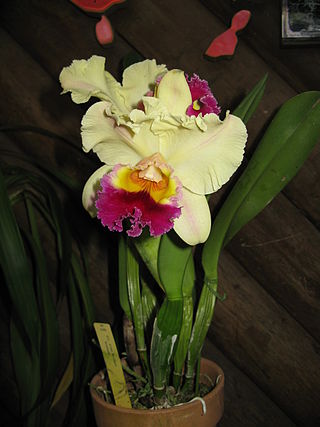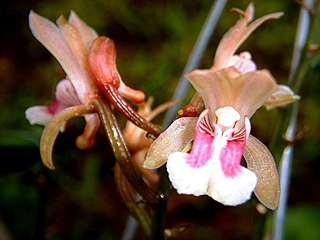
Brassavola is a genus of 21 orchids. They were named in 1813 by the Scottish botanist Robert Brown. The name comes from the Italian nobleman and physician Antonio Musa Brassavola. This genus is abbreviated B. in trade journals.

The taxonomy of the Orchidaceae (orchid family) has evolved slowly during the last 250 years, starting with Carl Linnaeus who in 1753 recognized eight genera. De Jussieu recognized the Orchidaceae as a separate family in his Genera Plantarum in 1789. Olof Swartz recognized 25 genera in 1800. Louis Claude Richard provided us in 1817 with the descriptive terminology of the orchids. (See External links below). The next step was taken in 1830-1840 by John Lindley, who recognized four subfamilies. He is generally recognized as the father of orchid taxonomy. The next important step was taken by George Bentham with a new classification, recognizing subtribes for the first time. This classification was first presented in a paper that Bentham read to the Royal Society in 1881. Then it was published in 1883 in the final volume of Genera Plantarum. The next great contributors were Pfitzer (1887), Schlechter (1926), Mansfeld (1937), Dressler and Dodson (1960), Garay (1960, 1972), Vermeulen (1966), again Dressler (1981). and Burns-Balogh and Funk (1986). Dressler's 1993 book had considerable influence on later work.

Octomeria is a plant genus belonging to the family Orchidaceae. The genus comprises about 150 species native to the Neotropics, mostly in Brazil.

× Brassolaeliocattleya, abbreviated Blc. in the horticultural trade, is the orchid nothogenus for intergeneric hybrid greges containing at least one ancestor species from each of the three ancestral genera BrassavolaR.Br., CattleyaLindl. and Laelia Lindl., and from no other genera.

× Potinara, abbreviated Pot in the horticultural trade, is the nothogenus comprising those intergeneric hybrids of orchids which have Brassavola, Cattleya, Laelia and Sophronitis as parent genera.

Laeliinae is a Neotropical subtribe including 40 orchid genera, such as Brassavola, Laelia and Cattleya. The genus Epidendrum is the largest within this subtribe, containing about 1500 species. This is followed by the genus Encyclia, with over 120 species.

Spiranthes is a genus of orchids in the subfamily Orchidoideae. They are known commonly as ladies tresses, ladies'-tresses, or lady's tresses. The genus is distributed in the Americas, Eurasia, and Australia. The genus name Spiranthes is derived from the Greek speira ("coil") and anthos ("flower"), and was inspired by the spirally arranged inflorescence.
Benthamia is a genus of orchids. It contains 29 recognized species, all native to Madagascar, Mauritius and Réunion.

Ceratostylis is a genus of orchids with more than 140 species distributed in China, India, Southeast Asia, New Guinea, the Philippines, and Melanesia.
Epiblastus is a genus of orchids with 22 known species distributed from New Guinea, Philippines, Maluku, Sulawesi, Fiji, the Solomons, the Bismarcks, Samoa and Vanuatu.

Notylia, abbreviated Ntl in horticultural trade, is a genus of orchids. It consists of 56 recognized species, native to Mexico, Central America, Trinidad and South America.

Campylocentrum is a genus of rare orchids native to Mexico, the West Indies, Central America and South America. One species (C. pachyrrhizum) extends its range into Florida.

Chiloschista, commonly known as starfish orchids and abbreviated Chsch., is a genus of usually leafless, epiphytic or lithophytic orchids found in India, Southeast Asia and Australia.

Epidendrum secundum, one of the crucifix orchids, is a poorly understood reed stemmed species, which Dressler (1989) describes as "the Epidendrum secundum complex." According to Dressler, there are dozens of varieties, some of which appear to deserve species rank. Arditti and Ghani note that E. secundum has the distinction of bearing the longest seeds known in the Orchidaceae, 6.0 mm long. By comparison, the seeds of E. ibaguense are only 2.9 mm long.

Fernandezia is a genus of flowering plants from the orchid family, Orchidaceae. It contains about 30-40 species, native to northern South America, Central America, and southern Mexico.
Mesadenus is a genus of flowering plants from the orchid family, Orchidaceae. It contains 6 currently recognized species, native to Mexico, Central America, the West Indies, Brazil and Florida.
- Mesadenus chiangii(M.C.Johnst.) Garay - Coahuila
- Mesadenus glaziovii(Cogn.) Schltr. - Rio de Janeiro
- Mesadenus lucayanus(Britton) Schltr. - widespread across Mexico, Florida, Guatemala, West Indies
- Mesadenus polyanthus(Rchb.f.) Schltr. - Mexico, Belize
- Mesadenus rhombiglossus(Pabst) Garay - Minas Gerais
- Mesadenus tenuissimus(L.O.Williams) Garay - Morelos

Oeceoclades, collectively known as the monk orchids, is a genus of flowering plants from the orchid family, Orchidaceae. It is related to Eulophia and like that genus is mostly terrestrial in habit. A few species extend into very arid environments, unusual for an orchid.

Cryptolepis is a plant genus in the family Apocynaceae. It includes some 42 species.

Rhyncholaelia digbyana is a species of epiphytic orchid occurring from Honduras to Belize, Guatemala, Mexico and Costa Rica.

















